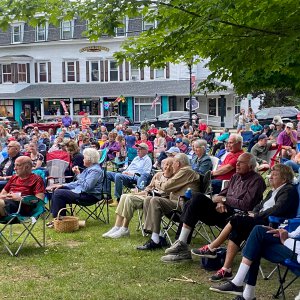Vintage Views: Rattlesnake Hill, Concord’s quarries, and our superior granite supply

Rattlesnake Hill Quarrymen pictured in 1890 transporting harvested granite down Rattlesnake Hill to the granite cutting sheds on North State Street. James W. Spain photo
| Published: 06-21-2024 4:00 PM |
Martin prepared to leave his home on North State Street for another day laboring on Rattlesnake Hill in Concord. He was a rugged quarryman and worked with hundreds of other men in the granite quarries in Concord.
Each morning as he walked to Rattlesnake Hill, his routine was evident. He carried his cloth-wrapped sandwich, canteen filled with water and faced another long day on the hill cutting and hauling Concord granite to the stone sheds at the bottom of the hill not far from his home.
Martin had arrived in Concord in 1850 with his brothers, Michael, Thomas and James, from a small town in Ireland. Unfortunate victims of the potato famine, these former tenant farmers were desperate to survive and signed on as indentured servants, pledging a period of time laboring in the textile mills of Manchester in exchange for passage on the next ship to Boston. The four brothers were focused on a future where they not only survived but prospered in the United States.
After their debt was paid, they ventured further north to Concord to work in the granite quarries, hard work with good pay was desirable – the work guaranteed many hours and the opportunity to not only survive but provide for a family.
One cold November morning, Martin left his home as his wife joined him at the door. Bridget was his new wife, herself a native of Galway Bay, where she grew up and boarded the ship to America in search of a better life. Bridget was a beautiful young Irish woman, her hair as black as the darkest night and her blue eyes as fair as the most brilliant sky. They met in the textile mills in Manchester and married after a short courtship, moving to Concord after. Bridget stepped toward her husband, embraced him and once again made him promise that he would be safe and return home unharmed. Her Irish wit was evident, “Martin! Promise me that you will be careful today!” With a slight smile she added, “Bridget Madden Spain will not sleep a widow!”
Martin agreed to her terms as he always did, pledging that he would indeed be careful.
Martin walked into the forest across the street at sunrise, consumed by the cold November early morning fog. Soon he was joined by many men trekking up the gravel road to the top of Rattlesnake Hill. The men would spend the next 12 hours laboring in different capacities, drilling, scoring and cutting large slabs of granite and then loading the fresh cut granite onto heavy wagons pulled by oxen or horses. Men would guide the granite-laden wagons to the bottom of the hill for finish cutting in the stone sheds.
During the cold winter months, the men would haul the granite down the very same road upon large sleds that were pulled by the same animals. Braking was crucial for the load was descending a steep hill year-round and a lost wagon could be deadly. Rattlesnake Hill has provided for the people of Concord for many generations.
Article continues after...
Yesterday's Most Read Articles
When the first settlers arrived, they found the old growth forest on top of Rattlesnake Hill was covered with large boulders. These boulders were harvested as the years progressed and cut into workable granite pieces. Rattlesnake Hill being located just a mile from the Statehouse allowed easy access and work for local laborers. The hill is about three miles in length, running north to south, the highest point being 580 feet above the high water mark of the Merrimack River.
The granite boulders initially harvested from the surface and cut were used in early construction. The stone for the original New Hampshire State Prison was quarried off Rattlesnake Hill in 1812 while the stone for the New Hampshire State House was harvested during the 1816-1819 period. Even though the stone used to build both structures was obtained from the surface of Rattlesnake Hill the quality was amazing and to this day shows little sign of weathering and decomposition.
Surface stone from Rattlesnake Hill was also used in Washington, D.C., for the construction of such buildings as the Congressional Library. The quality of Concord granite is superior and the supply inexhaustible, according to our ancestors first involved in the Concord granite industry. The stone obtained in Concord addresses all of the needs for fine construction, foundations, curbing, gravestones and even sculptures. There were monuments and sculptures around the country that are created using Concord granite, from the battlefields of Gettysburg to Boston where the Ether Monument, known as the “Good Samaritan” was erected many years ago.
During the summer of 1897 Professor W. C. Day from the United States Geological Survey found his way to Concord. After careful scientific analysis Professor Day declared Concord granite superior and stated “for hammered work, Concord granite cannot be excelled.”
As the granite industry grew, many people invested in opening new quarries and excavation was common. Rattlesnake Hill was aptly named because of the large numbers of Rattlesnake dens found in the early years. The quarrymen burned the hill in the early to mid-1800s in hopes of eliminating the potential harm inflicted by rattlesnake bites. In addition to burning the city offered a bounty on the snakes, which are today endangered.
These efforts, along with the ongoing decades of granite quarry development did take their toll on the rattlesnake dens. The burning of Rattlesnake Hill by our ancestors also sadly eliminated much of the old growth forests that the original settlers viewed.
Rattlesnake Hill has been very kind to the Concord community for well over a century providing employment to generations of quarrymen. To this day Rattlesnake Hill provides a forested refuge to much wildlife as well the people of our present-day community. The voices of the long-ago quarrymen have been silenced by the years, but a stroll to the historic Rattlesnake Hill is a walk back in time.
To walk the land of my grandfathers is indeed a very special gift. Martin Spain kept his promise to his wife Bridget until his very last days. Bridget Madden Spain never slept a widow.







 Lavender haze: Purple fields bloom at Warner farm
Lavender haze: Purple fields bloom at Warner farm Arts in the Park returns for July
Arts in the Park returns for July Hopkinton art gallery showcases “Creativity Beyond Convention”
Hopkinton art gallery showcases “Creativity Beyond Convention” AROUND CONCORD: Your guide to free summer music
AROUND CONCORD: Your guide to free summer music
